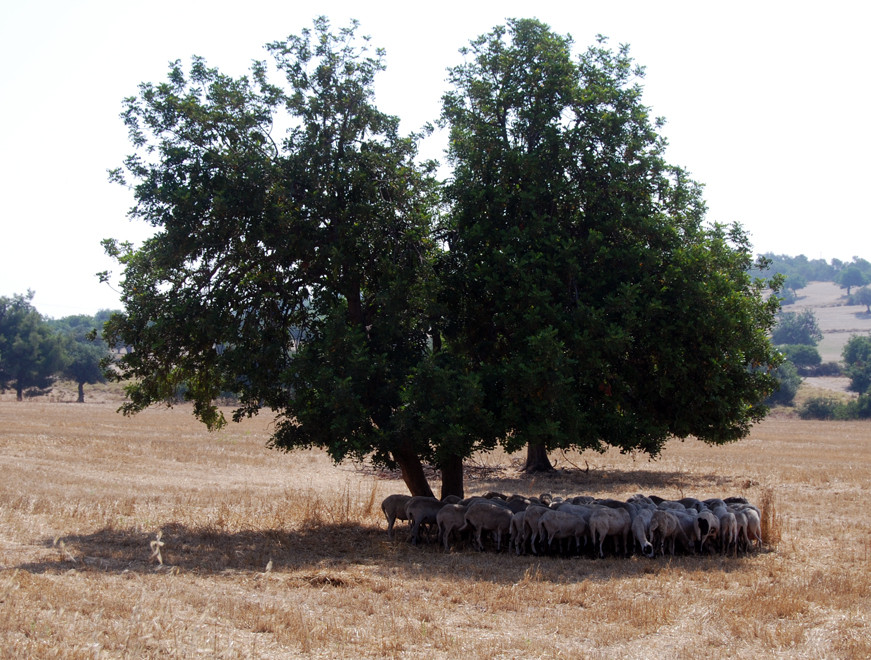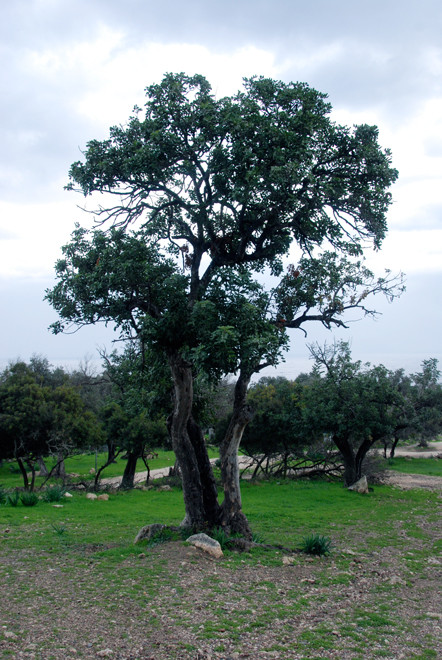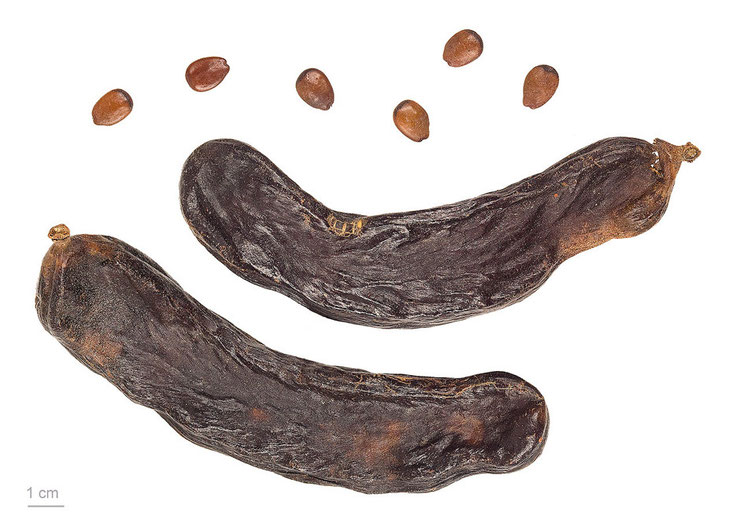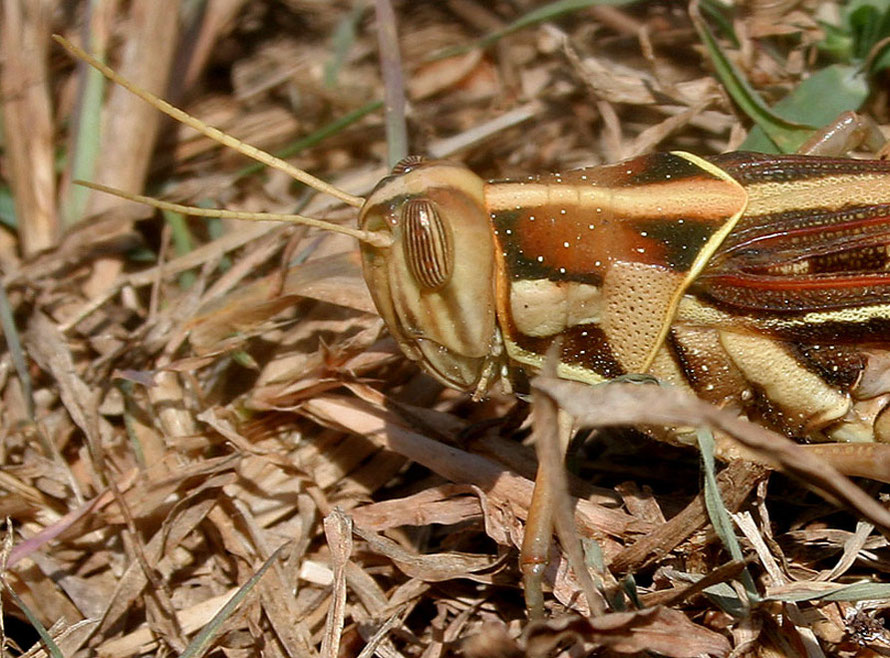VIII. Carob: The Locust Bean
Carob trees have existed in Cyprus since prehistoric times and their widespread cultivation was often commented on by travellers in the Middle Ages. The main centre of the industry was Limassol district, from where the carobs were collected, stored and exported in vast quantities.
The slow growing, evergreen Carob can live up to 200 years with a productive life of 80 to100 years. The leaves are broad and dark offering substantial shade. It sheds its leaves every second July whilst partially renewing them in April and May. It has growth spurts in spring and autumn. Its upper limit in Cyprus is 600 metres as its tolerance to temperatures below zero is limited.
Carob does particularly well on deep, chalky marginal soils and benefits in the coastal areas of Cyprus from better winter rains, warmer temperatures and higher relative humidity than in the higher hills and mountains (see W. Davies (1970) The carob tree and its importance in the agricultural economy of Cyprus, Economic Botany).
The Carob is a strange tree with its thick, evergreen, waxy, rounded, paired leaves and bulging, tumescent green pods which turn into scaly, shiny horn-like black-brown pods in the autumn. It foliage casts thick shadow but the form of the tree, which often splits into two trunks at the base, gives it the look of a ramshackle, mop-headed, bad-hair-day kind of plant.
It is something of a throwback in terms of its origins:
the genus, Ceratonia, belongs to the Fabaceae (legume) family, and is believed to be an archaic remnant of a part of this family now generally considered extinct (Wikipedia: Ceratonia siliqua).
And although a leguminous plant it is not nitrogen-fixing. It does however have a root bacteria believed to be from the Rhizobium genus that greatly improves the Carob's ability to take nitrogen from poor soils (see Batille, I. and J. Tous. 1997).
Carob trees (Ceratonia siliqua) were a mainstay of the Cypriot economy and know as 'the black gold of Cyprus'. For some villages the carob was the centre of agricultural activity and the main source of income.
The name itself derives from the Hebrew 'kharu'v- and the Arabic 'kharrub' and is 'charaoupi' in Greek. The latin name derives from the Greek 'keration' which means 'horn' and refers to the shape of the dried carob pods. In Cyprus a common name is 'terratsi'.
The carob is also known as the 'locust bean' or ‘St Johns Bread’ in ‘reference to the presumed use of its ‘locusts’ (beans) as food by St John the Baptist when in the desert (see below for more on this).
It is believed that their very uniform seeds were used by jewelers as a unit of weight (200mg), the carat (Wikipedia: Ceratonia siliqua).

The carob is only surpassed by the pistachio in its ability to withstand drought and has a clever system of thickening its leaf walls with leaf wax in dry periods to reduce ‘cuticular permeability’.
The tree is resistant to most pests and diseases – the carob moth being an exception – and requires little or no fertiliser and basically can be left to get on with its life. In Cyprus rats pose
problems by stripping bark from young trees and branches. There does not appear to be a carob seed and gum processing plant in Cyprus – the nearest one being in Italy (see Batlle, I. and J. Tous. 1997).
Magda Ohnefalsch-Richter, archaeologist and wife of Max Ohnefalsch-Richter (see my page Buying and Selling the Past) regarded the carob as the most important tree of the island in terms of tradition and economic importance. She said during her time in Cyprus at the end of the 19th century, 'without this gift of nature the island could have gone bankrupt long ago'.
She noted that Cyprus carobs were the best in the world due to their high sugar content and that during the period 1906/07 carob exports outstripped all other agricultural exports, a situation that only changed with the growing export of citrus fruit in 1950.
In the 1960s 2.4 million carob fruit-bearing trees yielded 48,000 tons (20kg of carobs per tree). And reached a record of 62,000 tons in 1968.
After the de facto partition of the island carob production in the south dropped to 20,000 tons p.a. between 1975 and 1985. In more recent times production has fallen drastically as the hectares under carob trees fell from 30,000ha to 1,600ha.
The old carob orchards have disappeared, often to be replaced by villa development, and trees now grow in the wild or in combination with other cereal cultivation. There is increasing unwillingness to harvest the dwindling crop because it is a difficult and labour intensive job - up to 35% of the labour input of the entire cycle of cultivation (see Batlle, I. and J. Tous. 1997 above).
The dark-brown pods are harvested in October by knocking them out of the trees with long poles at the same time as the tree is flowering, which makes for the need for careful harvesting to allow fruit-setting for the next year.
Pulp is produced from the pods of the carob for animal feed and for human consumption. A sweet syrup (charoupomelo/teratsomelo) can also be obtained boiling up the crushed pods and was used an an early energy drink by Cypriot farmers.
The seeds are processed to produce carob (or locust) bean gum (LBG) which is used as a natural stabilizing or thickening agent in food products especially confectionery, ice cream, baby and pet food.
Carob timber is hard and close-grained, and has been used to make tools as well as slow-burning charcoal.
A sweet, pastelli, was made from sugar rich pods and sesame(for above see Cyprus Foods).
Spain is the largest producer with 82,000ha and 41% of production. Spanish production greatly increased after phylloxera killed off vineyards in coastal regions but has more than halved since the 1970s.
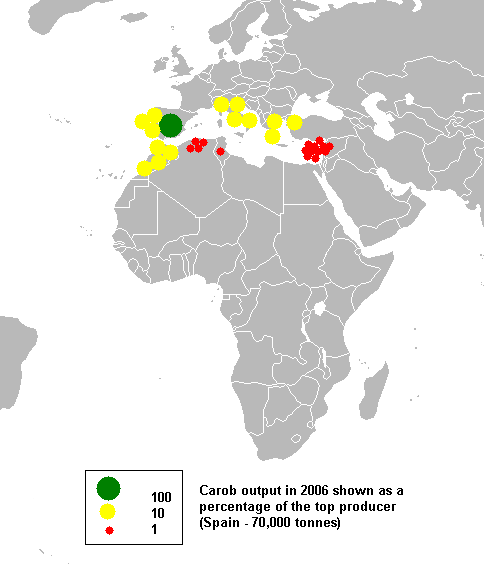
I have been puzzled by the name for the carob bean as 'locust bean'. Eventually an etymological definition suggested this was because the seeds bear some resemblance to a locust.
It wasn't until I got a photo of the seeds and a locust that I could see any similarity. But there is a striking one between the shape of the locust head and its mandibles and the carob seed.
English language dictionaries put the first use of 'locust bean' at the start of the seventeenth century. From my knowledge of locust plagues in Cyprus (see my page on the Locust Problem in Cyprus) this was certainly a time when they were very active.

Quite why the association between the locust head and carob bean became so strong is unclear. Perhaps it had something to do with the confusion between the 'locusts' John the Baptist was supposed to have eaten in the desert - which may or may not have been grasshopper-type locusts - and the way that the carob tree and bean also came to be known as 'St John's-Bread'. (The Carob pod and bean have been eaten by humans in times of famine and they store remarkably well making them a good standby subsistence food crop.)
It may not be a coincidence that the Knights Hospitaller were also known as the 'Knights of St. John' and were active in both Cyprus and Malta. In Cyprus their HQ at Kolossi had both a very active Carob orchard hinterland, in which they probably had a stake, and a very active Carob trading and exporting centre at nearby Limassol.
Maybe there was a conscious re-branding of the Arab sounding Carob - from 'kharrub' - to a strong Christian-Holy Land association through the 'John the Baptist eating locusts', to 'St. John's-bread' to 'Locust beans' nexus. Or maybe this happened spontaneously as a Hospitaller/Venetian trader reaction to, and supplanting of, the post-Crusades Muslim 'enemy's' language.
A paper on John the Baptist's Diet that I came across suggests that there was great debate between the fifth and twelfth century on the identification of John's diet in the desert. Apparently the assertion that the 'locusts' he ate with honey were in fact Carob seeds started in the medieval west (see Sebastian Brock).
See also Wikipedia:Matthew 3:4 where it is reported that two bible scholars, Albright and Mann, believed the attempt to portray John the Baptist as eating seed pods rather than grasshoppers, 'was concern for having such a revered figure eating insects and also a belief that a true ascetic should be completely vegetarian'. It seems that all 22 other times that the Bible refers to 'locusts' they are unambiguously insects and not Carob seeds. Locusts are surprisingly nutritious and produce five times more edible protein per unit of fodder than cows and produce less greenhouse gases in the process (see Wikipedia:Locusts).
I wrote a spoof piece - the #CarobRenaissance - as the details of the Cyprus
bailout were being hammered out one night. I thought it was quite funny at the time.
To Locusts: Gone But Not Forgotten



